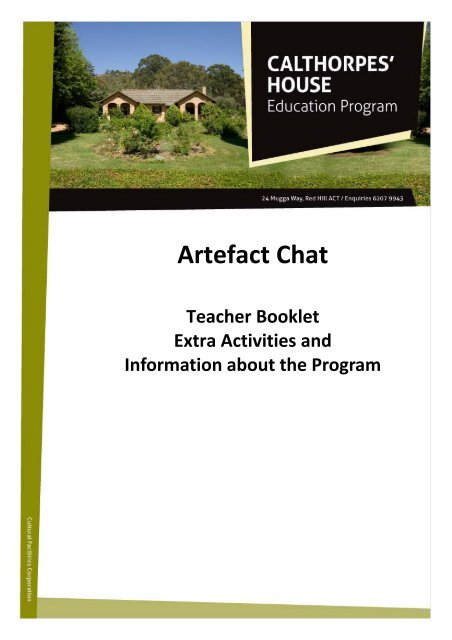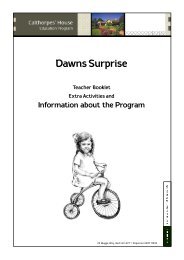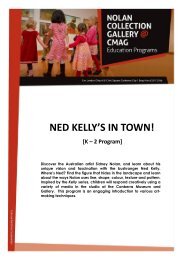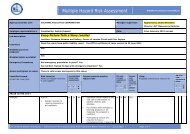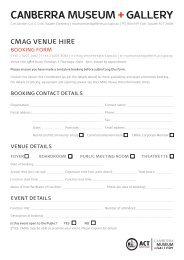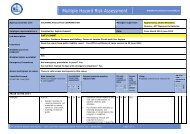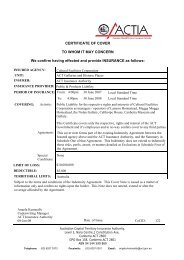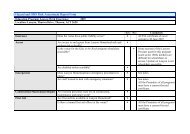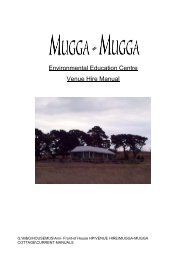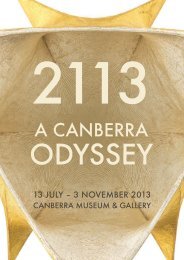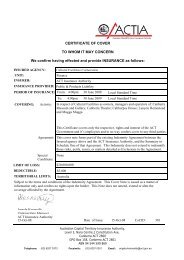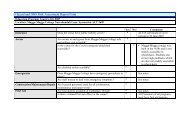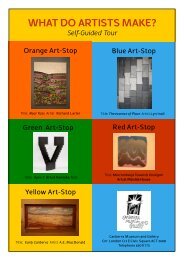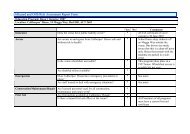Download Teachers Booklet - ACT Museums and Galleries
Download Teachers Booklet - ACT Museums and Galleries
Download Teachers Booklet - ACT Museums and Galleries
Create successful ePaper yourself
Turn your PDF publications into a flip-book with our unique Google optimized e-Paper software.
Artefact Chat<br />
Teacher <strong>Booklet</strong><br />
Extra Activities <strong>and</strong><br />
Information about the Program
Contents<br />
Program Summary p. 3<br />
Curriculum information p. 3<br />
Information about Calthorpes’ House p. 5<br />
Checklist for planning your excursion p. 6<br />
What will happen during the program p. 7<br />
Pre‐visit activities p.8<br />
Post‐visit activities p. 10<br />
References p. 12<br />
Artefact Chat<br />
Calthorpes’ House is a wonderful venue to learn about oral histories, <strong>and</strong> artefacts<br />
from Australia’s past. The house was built in 1927, <strong>and</strong> is significant as an almost<br />
intact collection of objects from the period which, with the gardens, allows<br />
students to enter a time capsule.<br />
The education program Artefact Chat includes a tour of the house <strong>and</strong> garden, an<br />
artefact study, <strong>and</strong> students will create a scrapbook collage reflecting the<br />
museum.<br />
This onsite excursion is supported by the online outreach Education Program<br />
Artefact Chat, for which further information can be found at the following<br />
website: www.museums<strong>and</strong>galleries.act.gov.au/artefactchat<br />
The following information is provided to assist teachers in making the most of<br />
their visit to Calthorpes’ House. Please note the checklist for planning your<br />
excursion is on page 6.<br />
2
Program Summary<br />
Name of Program Artefact Chat<br />
Target Audience Years Foundation ‐ 2<br />
Length of Program 1½‐2 hours<br />
Availability of Program Tuesday ‐ Friday<br />
Size of Group<br />
30 students maximum<br />
A ratio of 1 adult supervisor to 10 students is required.<br />
Cost<br />
$6.50 per student<br />
Accompanying adults free<br />
Aim<br />
The program explores the concepts of artefacts <strong>and</strong> how they inform oral<br />
histories. The students are provided with insight into the artefacts owned by, <strong>and</strong><br />
experiences of, a family living in Canberra in the 1930s through four activities; a<br />
tour of the house, an artefact study, a tour of the garden, <strong>and</strong> a craft activity. The<br />
engagement is active <strong>and</strong> h<strong>and</strong>s‐on.<br />
Philosophy<br />
The strategies used in this program are experiential discovery. Students are<br />
encouraged to engage with the site through the h<strong>and</strong>s‐on activities. As a result of<br />
these strategies the responses from the group will influence the information that<br />
is provided during discussion.<br />
Curriculum Information<br />
Historical Skills ‐ Analysis <strong>and</strong> use of sources<br />
Identify <strong>and</strong> compare features of objects from the past <strong>and</strong> present (ACHHS035);<br />
Comparing objects from the past with the present to identify similarities<br />
<strong>and</strong> differences (for example toys, whitegoods, televisions, radios).<br />
Historical Skills ‐ Historical questions <strong>and</strong> research<br />
Pose questions about the past using sources provided (ACHHS033);<br />
Discussing what life was like for their parents <strong>and</strong> gr<strong>and</strong>parents by<br />
examining everyday objects (for example telephone, radio, cooking<br />
utensils, toys), photos <strong>and</strong> stories from the past, using ‘What’ How’<br />
‘When’ ‘Why’ questions.<br />
Historical Knowledge <strong>and</strong> Underst<strong>and</strong>ing ‐ The Past in the Present<br />
The history of a significant person, building, site or part of the natural<br />
environment in the local community <strong>and</strong> what it reveals about the past<br />
(ACHHK044);<br />
3
Investigating the history of a chosen person, building, site or l<strong>and</strong>mark in<br />
the local community using sources (for example books, newspapers, oral<br />
histories, audio visual material, digital sources, letters, photographs) <strong>and</strong><br />
relating a story which these reveal about the past.<br />
Historical Skills ‐ Chronology, terms <strong>and</strong> concepts<br />
Distinguish between the past, present <strong>and</strong> future (ACHHS048);<br />
Using terms to denote the passing of time in speech <strong>and</strong> writing (for<br />
example ‘in the past’, ‘years ago’, ‘the olden days’, ‘in the future’).<br />
Historical Skills ‐ Historical questions <strong>and</strong> research<br />
Pose questions about the past using sources provided (ACHHS049);<br />
Developing inquiry questions about a site (for example ‘What does it look<br />
like now’ ‘What condition is it in’ ‘How might its use have changed’<br />
‘What was its purpose’ ‘How was it built/created’ ‘How was it paid for’<br />
‘What is its use <strong>and</strong> importance in the present’).<br />
Historical Skills ‐ Explanation <strong>and</strong> communication<br />
Use a range of communication forms (oral, graphic, written, role play) <strong>and</strong> digital<br />
technologies (ACHHS054);<br />
Representing ideas <strong>and</strong> creating imaginative responses through visual<br />
images as well as written <strong>and</strong> spoken descriptions <strong>and</strong> narratives.<br />
4
Information about Calthorpes’ House<br />
The following information provides both an introduction to Calthorpes’ House, the<br />
family <strong>and</strong> the artefacts. This may be information you would like to share with<br />
your students in preparation for their visit to Calthorpes’ House.<br />
Calthorpes’ House was built in 1927, the year the Provisional Parliament House<br />
opened in Canberra. Mr Harry <strong>and</strong> Dell Calthorpe lived in the house with their<br />
two daughters Dawn <strong>and</strong> Del. The Calthorpe family also lived with their maid,<br />
Mary. Dawn <strong>and</strong> Del had many pets to feed <strong>and</strong> play with, the cat’s name was<br />
Tiddles, the canary was Glad, <strong>and</strong> the dog was called Johnson.<br />
The truly unique feature of Calthorpes’ House is that everything in the house<br />
actually belonged to Harry, Del, Dawn <strong>and</strong> Dell. The question of what is real <strong>and</strong><br />
what is a reproduction is not a factor. The house is an artefact, <strong>and</strong> Dawn has told<br />
many oral histories about her memories of living in the home. The connection<br />
between the oral histories <strong>and</strong> the artefacts throughout the house <strong>and</strong> garden is<br />
immediate, for example, all the toys <strong>and</strong> books in Dawn’s bedroom really are the<br />
ones she played when she was a child.<br />
5
Checklist for planning your excursion<br />
<br />
<br />
<br />
<br />
<br />
<br />
<br />
Clothing: Calthorpes’ House programs are indoor <strong>and</strong> outdoor excursions that<br />
involve walking. Warm, waterproof attire is important in the cooler months<br />
<strong>and</strong> sun protection is also a priority throughout the year. Calthorpes’ House<br />
backs onto Red Hill <strong>and</strong>, due to snakes, long pants <strong>and</strong> closed toed shoes are<br />
required. It is recommended visiting <strong>Teachers</strong> are familiar with the <strong>ACT</strong><br />
Government Territory <strong>and</strong> Municipal Services Living with Snakes information,<br />
particularly the section title ‘Avoid being bitten’, which can viewed at the<br />
following location:<br />
http://www.tams.act.gov.au/play/pcl/wildlife/local/living_with_snakes<br />
<strong>ACT</strong> <strong>Museums</strong> <strong>and</strong> <strong>Galleries</strong>’ staff retain the right to refuse entry to students<br />
who are inadequately dressed.<br />
Weather: The programs are offered in all weather. The decision to postpone<br />
the excursion lies with the school. If you decide to postpone your booking,<br />
please ring 6207 9943 <strong>and</strong> 0424 585 464 as soon as possible so we can notify<br />
the Presenters. If a catastrophic fire danger rating is issued by <strong>ACT</strong> Emergency<br />
Services or a severe weather warning is issued by the Bureau of Meteorology<br />
the program will be cancelled by the <strong>ACT</strong> Historic Places Education Officer.<br />
Camera/photographic device: Please bring up to three cameras/photographic<br />
devices, as the success of this program relies upon up to three photographs<br />
being taken by two accompanying adults during the program. Any<br />
photographic device will suffice for example; smart phone, iPad, digital<br />
camera, etc. It is imperative to one of the program outcomes that schools<br />
provide their own photographic equipment as there is none provided on site.<br />
Student preparation for the excursion: Divide the class into a maximum of<br />
three groups (with a maximum of 12 students in each group) with at least one<br />
adult for each of these smaller groups.<br />
Please ensure that every student wears a name tag. This makes it much easier<br />
for the Presenters to communicate effectively with the students.<br />
Morning Tea <strong>and</strong>/or Lunch: It is best that students do not bring school bags<br />
as they cannot take these on the program. Lunches should be collected into a<br />
few tubs. On arrival your Presenters will show you where to put the food. It is<br />
recommended students drink fluids during Morning Tea <strong>and</strong>/or Lunch. There<br />
are no bins provided, please take your rubbish away with you.<br />
First Aid Kit: Please bring your First Aid Kit. Please note that our First Aid Kit<br />
does not include medications, nor can we supply equipment for allergic<br />
reactions such as an EpiPen. Please ensure you bring with you any medicines<br />
your students should require while they are at Calthorpes’ House.<br />
6
Special Needs: Please advise the Bookings Officer at the time of booking if<br />
there are students in your group with particular needs so that staff can be<br />
prepared to assist in appropriate ways <strong>and</strong> vary the program as necessary.<br />
Risk Management Plan: Please check the Risk Management Plan for Artefact<br />
Chat, available from our website at the following link ‐<br />
http://www.museums<strong>and</strong>galleries.act.gov.au/calthorpes/education.html<br />
What will happen during the program<br />
Artefact Chat encourages students to engage with Calthorpes’ House through<br />
three activities; a tour of the house <strong>and</strong> garden, an artefact study, <strong>and</strong> students<br />
will create a scrapbook collage reflecting the museum.<br />
Arrival: Your bus will not be able to enter the grounds of Calthorpes’ House, as<br />
the driveway is too narrow. Please do not park the bus on the verge. Please<br />
disembark on the nature strip on the Calthorpes’ House side of the Mugga Way.<br />
The road is busy <strong>and</strong> entrance to the museum is just below a crest, therefore we<br />
recommend students do not cross Mugga Way to access the property. When<br />
you have disembarked, you will be met by a Presenter who will direct the group<br />
along the driveway to the Garage at the rear of the house.<br />
During the program: The introduction to the program will occur in the garage.<br />
After the introduction the students will be divided into the smaller groups. Each<br />
group should be accompanied by at least one adult. Each group will carry out the<br />
same program activities in a different order.<br />
The House: Students will tour the house to look at <strong>and</strong> discuss key artefacts, <strong>and</strong><br />
to listen to oral histories associated with key artefacts. Only the Presenter will<br />
h<strong>and</strong>le collection items using gloves.<br />
Before entering the house, students <strong>and</strong> accompanying adults will be required to<br />
put shoe covers over their shoes. This helps to protect <strong>and</strong> conserve the floor<br />
coverings. The Presenter <strong>and</strong> teachers should ensure booties are secure around<br />
students’ ankles so as to reduce risk of tripping on excess fabric. The Presenter<br />
will wear white gloves to h<strong>and</strong>le collection items.<br />
The Garden: Whilst visiting the garden, each group will be looking for a location<br />
where a photograph was taken when the Calthorpe family lived in the house. The<br />
group will have their photograph taken in the garden, <strong>and</strong> this image can be stuck<br />
onto the scrapbook page when they return to school. The focus of this rotation is<br />
how artefacts can inspire oral histories. Please note there are some safety rules<br />
7
that need to be observed in the garden, students need; long pants <strong>and</strong> closed toes<br />
shoes, <strong>and</strong> to remain in a group behind their Presenter.<br />
The Garage: Students will carry out the scrapbook collage. Students will use<br />
images of Calthorpes’ House, along with papers <strong>and</strong> other materials to create<br />
their own scrapbook page. When they return to school, the photograph taken in<br />
the garden can be pasted into the centre of the page, so that each student has<br />
their own artefact that can prompt a personal oral history of the day they visited<br />
Calthorpes’ House.<br />
Pre‐Visit Activities<br />
Read: Wilfred Gordon McDonald Partridge by Mem Fox <strong>and</strong> Julie Vivas. This story<br />
book can be used to introduce students to the idea that objects can prompt<br />
memories. This idea can be used to introduce the concepts of artefacts <strong>and</strong> oral<br />
history.<br />
Artefact detective: In the story book by Mem Fox, Wilfred selects his<br />
gr<strong>and</strong>father’s medal to share with Miss Nancy. Recall with the students how Miss<br />
Nancy reacted, <strong>and</strong> what she said, when she touched the medal. Ask the students<br />
if any of their family member have won a war medal. Tell the students about<br />
Harry Calthorpe; he fought at Gallipoli, Turkey, during World War I, where he was<br />
injured by an exploding shell in 1915. Invite the students to look carefully when<br />
they visit Calthorpes’ House to find Mr Calthorpes’ war medals, hint; they are<br />
displayed in the garage!<br />
Image: Harry Calthorpe was living in Cootamundra when World War I was declared.<br />
He enlisted immediately <strong>and</strong> can be seen toward the back of the photograph<br />
smartly dressed in suit, hat <strong>and</strong> bow tie.<br />
8
Vocabulary: Create a class glossary of unfamiliar words the students might<br />
encounter on the program, such as; artefact, oral history, museum, collection,<br />
scrapbook, collage.<br />
Location: Use a map of Canberra showing Calthorpes’ House. Locate points of<br />
interest to help the students underst<strong>and</strong> how to read the map. Show them where<br />
to read the suburb <strong>and</strong> street name. If the school is local to Canberra; find the<br />
school, Lake Burley Griffin, <strong>and</strong> the streets of some of the children in the class.<br />
Point out the proximity of Calthorpes’ House to Parliament House, Civic, etc.<br />
Compare the map to a historical map of Canberra. Appropriate maps <strong>and</strong><br />
l<strong>and</strong>scape views are avaliable at the following link,<br />
http://www.idealcity.org.au/competition‐2‐information_materials.html, these<br />
digitised images were sent to entrants of the Canberra design competion in 1911.<br />
When comparing the old <strong>and</strong> new maps, discuss what has changed. Alternatively,<br />
to answer this question, describe changes in the l<strong>and</strong>scape by comparing a recent<br />
photograph of Canberra to photographs taken in the past. After looking at the<br />
various maps <strong>and</strong> photographs, student could talk about what they think they will<br />
you see during their journey to Calthorpes’ House.<br />
House rules: Mrs Calthorpe had at least 21 rules in her new house at 24 Mugga<br />
Way, <strong>and</strong> those rules were:<br />
No slamming doors<br />
No muddy feet<br />
No running in the house<br />
No fingers on the walls<br />
No feet on the chairs<br />
No rings around the bath<br />
No clothes on the floor<br />
No blowflies<br />
No smoking fires<br />
No empty wood boxes<br />
No splatters of boot polish<br />
No music or rolls left on the pianola<br />
No gramophone records left on the floor<br />
No chair arms to be used as pincushions<br />
No socks or picnic rugs with grass seeds<br />
No cobwebs<br />
No washing on the line on Sunday<br />
No dirty fingernails<br />
No ugly words<br />
No singing at the table<br />
No cabbage or cauliflower water to be poured down the kitchen sink<br />
9
Are there any rules Mrs Calthorpe had that are the same for students’ homes<br />
today What can the class tell about Calthorpes’ House from these rules, for<br />
example; are there hints about what they ate, what type of heating the house<br />
had, how they behaved during meal times, etc Talk about rules the students<br />
have in their classroom or at home. How do they compare to the rules Mrs<br />
Calthorpe for her family<br />
Create: Before the students visit Calthorpes’ House, conduct an oral history<br />
interview about an artefact that is important to them. Students could choose an<br />
artefact from home <strong>and</strong> bring it, or a photograph of the artefact, to school.<br />
As a class think of questions for each artefact, for example;<br />
Why is this artefact special, How old is the artefact, Why did you choose this<br />
artefact, What do you remember about this artefact, etc. This will enable<br />
students to be familiar with the terms ‘artefact’ <strong>and</strong> ‘oral history’ before they visit<br />
Calthorpes’ House where they will hear oral histories in relation to artefacts once<br />
owned <strong>and</strong> used by the family. They will also become familiar with the idea that<br />
artefacts don’t need to be old to have importance <strong>and</strong> significance to people.<br />
Post visit Activities<br />
Listen: Read the following passage to the students, an oral history told by Dawn:<br />
The day I invite my mother to lunch in the cubby is another disaster. I borrow a<br />
new breakfast cloth to fold over the vegetable box. I set the table with my little<br />
blue tin plates <strong>and</strong> a pretty anchovette jar with wildflowers in the centre. When I<br />
take the hot potatoes out of the coals, the ash falls on to the cloth <strong>and</strong> burns a<br />
hundred holes. My mother jumps up in agitation from the soap box seat.<br />
Create: Draw or paint the scene that was described in the oral history above.<br />
Cook: With teacher supervision, students could carry out a cooking activity by<br />
baking potatoes. Prick each potato with a fork, wrap in tin foil, <strong>and</strong> place in a hot<br />
oven. An adult should check the baking progress. Remove them from the oven,<br />
wait until the potatoes have cooled, slice in sections <strong>and</strong> eat with butter!<br />
Listen: The Calthorpe family had a radio, pianola, <strong>and</strong> gramophone <strong>and</strong> enjoyed<br />
listening to music. They also enjoyed sing‐a‐longs. Some of the songs they sang<br />
were; It's a long way to Tipperary, Bye Bye Blackbird, Oh I do like to be beside the<br />
seaside <strong>and</strong> Ain't we got fun. Weblinks to these songs are listed in the References<br />
at the end of this booklet.<br />
Favourite Sayings: Dawn tells oral histories about her father, Harry, <strong>and</strong> his many<br />
friendly sayings. One saying Dawn remembers her father saying to her is, ‘get a<br />
wriggle on.’ Ask the students what they think this means. Does anyone still use<br />
that saying in their family What other friendly sayings do we use today<br />
10
More classroom ideas: Further examples of ideas that can extend <strong>and</strong> enhance<br />
your excursion to Calthorpes’ House can be found at the ANCARA website, <strong>and</strong> a<br />
weblink for this site is listed in the References at the end of this booklet.<br />
11
References<br />
<strong>ACT</strong> Heritage Council. 2001 Calthorpes’ House Entry to the <strong>ACT</strong> Heritage Register.<br />
<strong>Download</strong>able from:<br />
http://www.tams.act.gov.au/__data/assets/pdf_file/0003/13359/232.pdf.<br />
Australian Curriculum: History, Foundation – Year 10, Australian Curriculum,<br />
Assessment <strong>and</strong> Reporting Authority,<br />
http://www.australiancurriculum.edu.au/History/Curriculum/F‐10<br />
Australian Curriculum, Assessment <strong>and</strong> Reporting Authority,<br />
http://www.acara.edu.au/curriculum/worksamples/AC_Worksample_History_1.p<br />
df<br />
Bickford, Anne. 2003. Calthorpes’ House. Cultural Facilities Corporation, Canberra.<br />
Burness, Elizabeth Pickhaver. Illustrations. In Jo Pillinger, Dawns’ Surprise. <strong>ACT</strong><br />
<strong>Museums</strong> <strong>and</strong> <strong>Galleries</strong>, Canberra.<br />
Gibbney, James. 1986. Calthorpes’ Canberra The Town <strong>and</strong> Community in 1927.<br />
Calthorpes’ House Museum: occasional series no. 1. Australian Government<br />
Publishing Services, Canberra.<br />
Lawson, Elaine. 1993. Calthorpes’ House Notes on the house, contents <strong>and</strong><br />
Conservation philosophy.<br />
Waterhouse, Dawn. 2002. Chortles, Chores <strong>and</strong> Chilblains Cameos of Childhood in<br />
Calthorpes’ House, Canberra. <strong>ACT</strong> Historic Places, Cultural Facilities Corporation,<br />
Canberra.<br />
<strong>ACT</strong> Government, 2010‐current. Hazard <strong>and</strong> OHS Risk Assessment form: Artefact<br />
Chat. <strong>Download</strong>able from:<br />
http://www.museums<strong>and</strong>galleries.act.gov.au/calthorpes/education.html<br />
Information about, <strong>and</strong> lyrics for, It’s a long way to Tipperary, can be found at;<br />
http://en.wikipedia.org/wiki/It%27s_a_Long_Way_to_Tipperary<br />
Information about, <strong>and</strong> lyrics for, Bye Bye Blackbird, can be found at;<br />
http://www.youtube.com/watchv=eO6PpD‐tRLU<br />
Information about, <strong>and</strong> lyrics for, Oh I do like to be beside the seaside, can be<br />
found at; http://www.youtube.com/watchv=XmJVXHLjVhk<br />
Information about, <strong>and</strong> lyrics for, Aint we got fun, can be found at;<br />
http://www.youtube.com/watchv=c9gjSqoDrK4<br />
12
24 Mugga Way<br />
Red Hill, <strong>ACT</strong><br />
Education Officer Phone: (02) 6207 9943<br />
13


